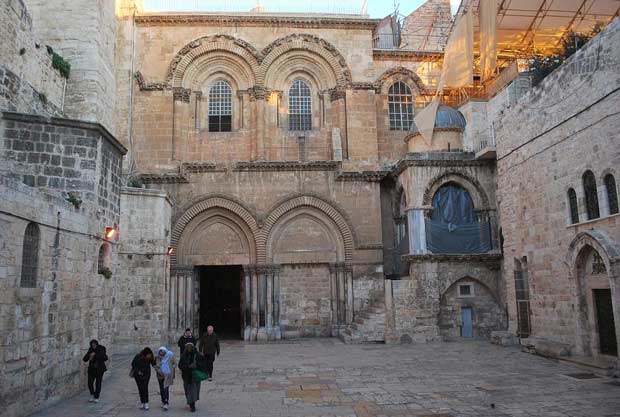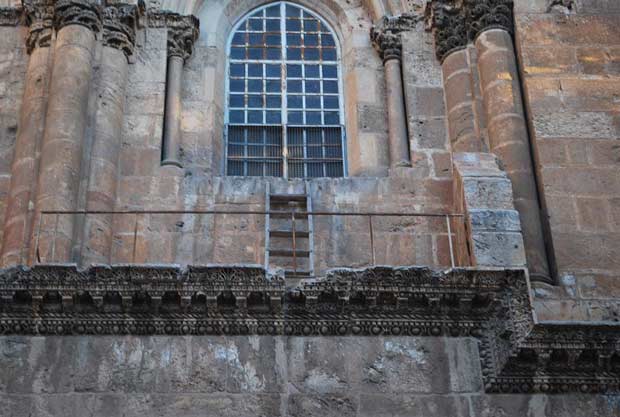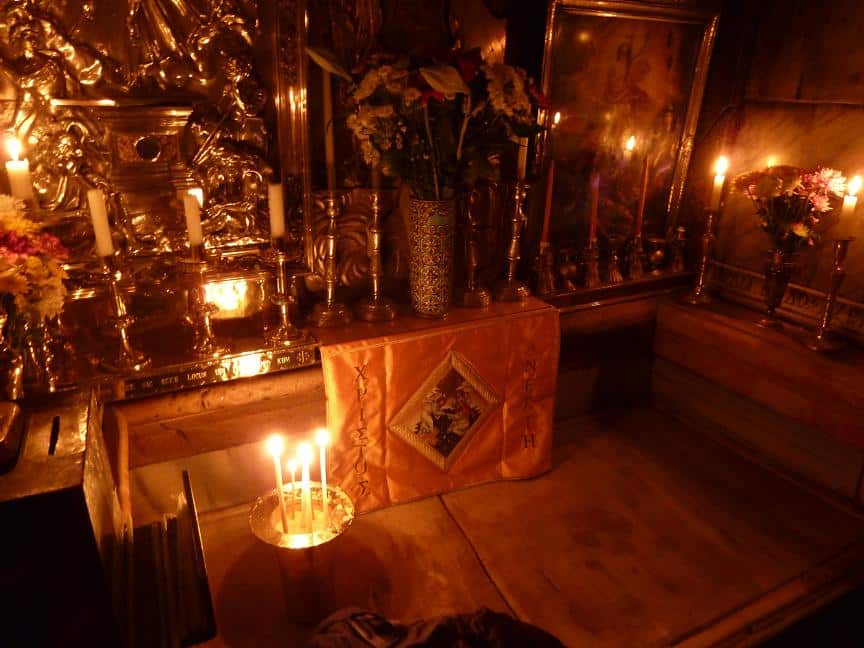Check out our shop where you can purchase tours! Learn More
Opening hours: April–September: 5:30–21:00
October–March: 4:30–19:30
Entrance fee: Free
The Church of the Holy Sepulchre is the holiest place for most Christians around the world. Wars, earthquakes, and the many additions and changes made to this house of worship in the last 1,700 years have lessened its impressiveness. The real beauty lies in its story.

The church was built in the year 335 CE by Helena, the mother of Constantine, who according to tradition was the one to locate the site of the crucifixion. Very little remains of the original structure of the church. The external façade of the church that you see today is mostly from the Crusader period (the 12th century). The church contains two very important sites – Golgotha (or Calvary), the place where Jesus Christ was crucified, and his grave. Many imagine Golgotha as a mountain outside of the Old City, but that’s not the case; it lies within the church.
This church is also special because it doesn’t belong to any one of the specific Christian denominations. Instead, it is divided between six different denominations. Most of the church is in the hands of the Roman Catholics (Franciscans), the Eastern Orthodox, and the Armenians. The small remainder is split between the Syriac Orthodox, the Copts, and the Ethiopians.
The different denominations never got along with each other. In 1852, after hundreds of years of quarrels, clashes, and wars, the Ottomans forced them to sign a status quo agreement in which they swore to accept the current arrangement. The agreement was very detailed and not only included the division of the territory, but also who is allowed to pray where and when, and even who has the right to turn on the lights.
The best-known symbol of the status quo is the Immovable Ladder, a wooden ladder leaning against the façade of the church underneath the upper right window. The Armenians set the ladder there because there were periods in which the Muslims closed the church with the monks still inside. In order to get food, the Armenian monks would climb out the window and down the ladder to a small porch where there was a rope.
The Armenians in the city would place food and drink in a pail on the ground, which the monks would haul up using the rope. Today the church is open every day, and there is no use for the ladder. So why is it still there? Because that is what is written in the status quo agreement: the Armenians have the right to place a ladder there. So even if it were to rot or break, the Armenians would replace it with a new one.

To the many visitors, the conflicts and squabbles between the different denominations seem petty and unworthy of the place. Even if there is truth in this, it’s important to remember that for these denominations this is the holiest place in the world. They have inhabited this building for hundreds of years, and no one wants to give in on anything or have anyone impinge on their rights. And what about the Protestants?
The Protestants came to Jerusalem 130 years ago and claimed that the Church of the Holy Sepulchre was built in the wrong place – because Jesus was a Jew and Jews do not bury their dead within the city, and since the church lies within the Old City, the grave cannot be there. The Protestants are right. Jews, as we have said, bury their dead outside of the city’s borders.
The Protestants simply pulled the rug out from beneath millions of believers who have come to the church for hundreds of years. The Protestants may have been right about the burial, but they were wrong about the city. The church has been within the city’s borders for the last five hundred years, but two thousand years ago, in Jesus’ time, that territory was outside of the city. Thus it’s quite possible that Jesus was crucified and buried there. Despite that, the Protestants, who have no claim on the church, have found themselves an alternative place.
Groups of Protestant believers come to a beautiful garden that lies outside of the Damascus Gate. To the Protestants, the exact location where Jesus was buried, fell, or prayed on a rock is not as important as the atmosphere – and in the Garden Tomb there is indeed a quiet and peaceful atmosphere. The Church of the Holy Sepulchre is locked every night and opened early in the morning. Like everything about the church, even something as simple and supposedly routine as this has a surprising story behind it. Saladin conquered Jerusalem in 1187. He took the keys from the Christians and gave them to two Muslim families – the Joudehs and the Nusseibehs – and for the last eight hundred years, they have been responsible for opening the church.
Every morning (5:30 in the summer, 4:30 in the winter), representatives from the Eastern Orthodox, the Roman Catholics, and the Armenians who sleep inside the church meet in front of a door inside the building. Only the Orthodox representative can open the small window in the door. Every morning, a different denomination is allowed to pass a small ladder through the window. A member of the Joudeh family that has the keys hands them to a member of the Nusseibeh family, who then climbs up the ladder to open the lock. After that, the Nusseibeh family member climbs down the ladder to open the doors of the church and returns the keys to the Joudeh family member. At night, there is a locking ceremony in which these same steps are repeated, simply in the reverse order.

+ Discount Codes
…or as a PDF
©2024 Traveling Israel. All rights reserved. | SITEMAP | TERMS & CONDITIONS